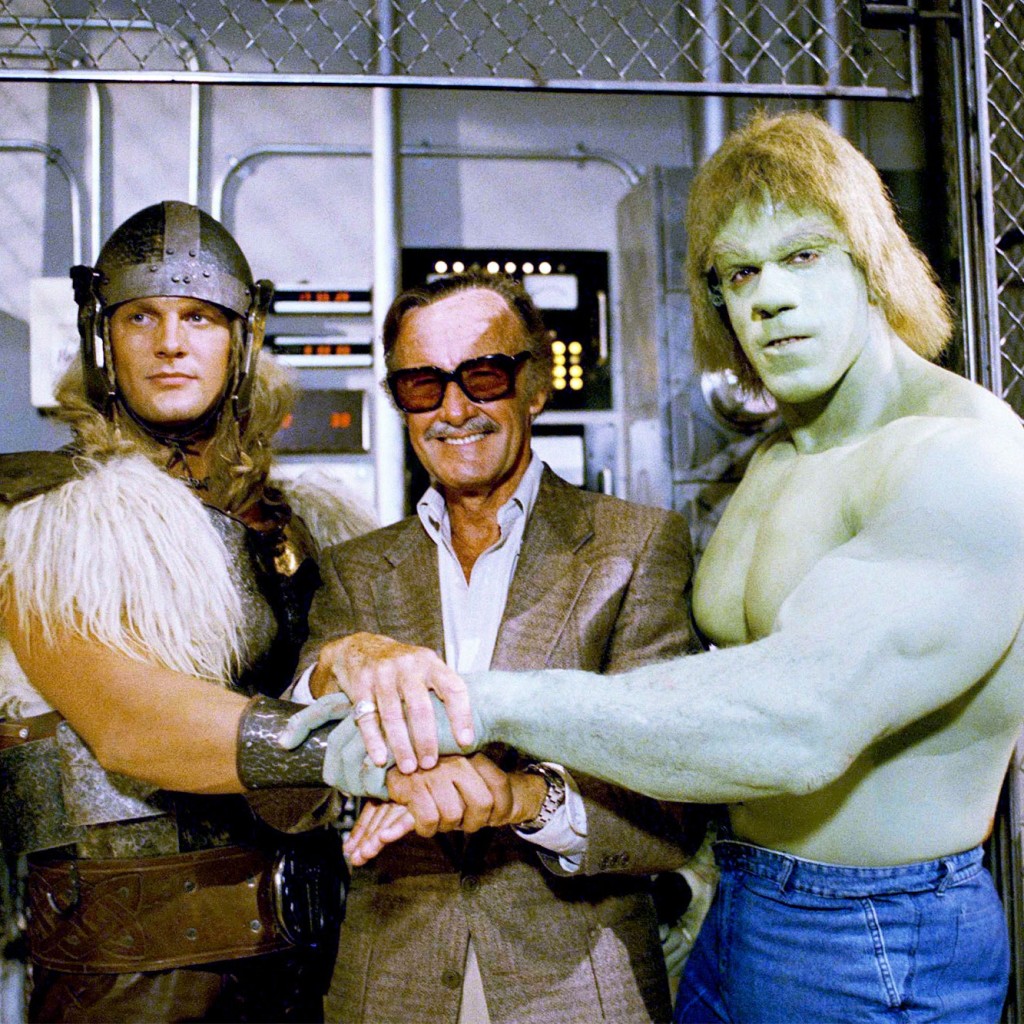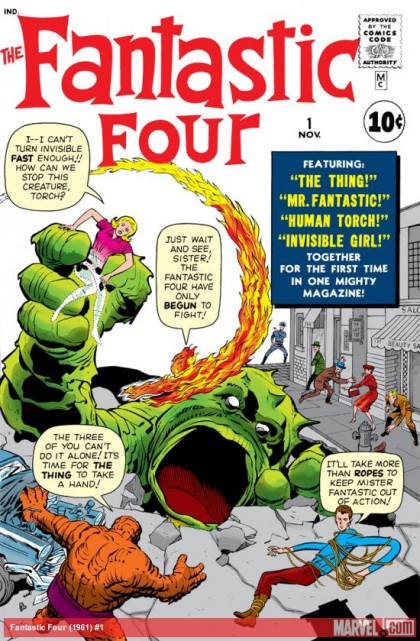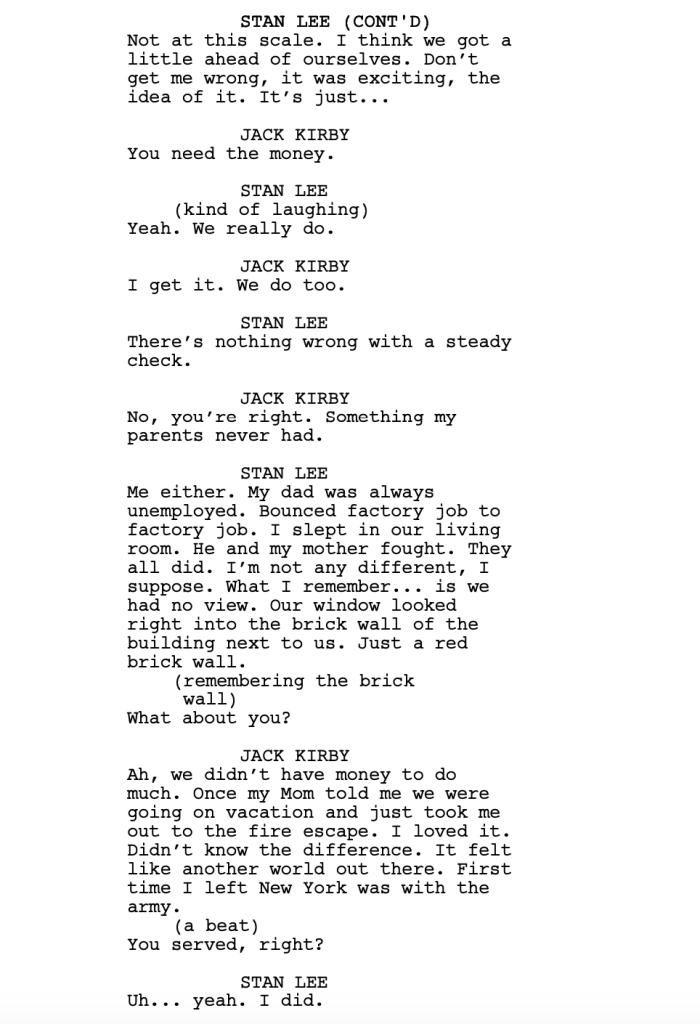Genre: Biopic
Premise: The true story of the meteoric rise (and subsequent fall) of Marvel Comics and the star-crossed creators behind the panel: Stan Lee & Jack Kirby.
About: This script finished on last year’s Black List with 9 votes. It comes from Alex Convery, whose script, “Bag Man,” I’ve reviewed on the site. That script is about the guy who delivers money to big college sports prospects to get them to commit to their school. It was a good script. We’ll see if Alex is 2 for 2.
Writer: Alex Convery
Details: 119 pages
You guys know me. I’m not a biopic guy. But I’ve always been curious about Stan Lee. Specifically that he ended up selling Marvel for nothing only for it to become the biggest franchise in movie history. That can’t be an easy pill to swallow. I also have a morbid fascination with seeing how yet another writer deals with the awkward monstrosity known as the biopic structure.
Excelsior starts in a boardroom in a situation not unlike The Social Network. It’s 2006 and 83 year old Stan Lee is suing Marvel for 10 million dollars. Marvel’s lawyers aren’t letting him off easy. In order to prove Lee doesn’t deserve the 10 million dollars, they want him to go back to the beginning and explain HIS ENTIRE CONTRIBUTION.
So that’s where we go. 44 years ago, when a 39 year old Stan Lee was working for a magazine that put little miniature comic books in the back of every episode. Stan, by any measurable definition, was a failure. He wrote up little outlines for comics that always sucked.
So when competing comic book company, DC, came out with the first ever comic, Justice League, to put all of their superheroes in a single story, Stan’s mind began racing. What could he do to revolutionize comic books? He needed to come up with something fast. While the rest of his friends were starting families and buying big houses, Stan and his wife, Joan, lived in a tiny 1-bedroom.
But then inspiration hit. Stan realized that superheroes were kinda boring. They didn’t have any depth. They just smiled in their costumes and saved the day. What if he could create a comic book with superheroes that represented real people? They had real problems. Real issues.
Stan knew there was only one person who could help him with his vision, artist Jack Kirby. The only problem was that the introverted Kirby hated Stan’s boss. He didn’t want anything to do with him. “Why don’t we start our own comic book brand? Own the rights?” Jack asked. “Soon,” Stan said. “But for right now, let’s play by the rules.”
Once Fantastic Four became a huge hit, Marvel was born. Next came the Hulk. And, after that, Spider-Man. The two artists were on fire, the toast of the comic book industry. And yet they were doing all of this for their corporate overlord. They didn’t own any of it, which incensed Kirby, who couldn’t get Stan to see how valuable it would be to quit and do their own thing.
Eventually, a big corporate player comes in and buys Marvel Comics, making Stan Lee its front man. By that point, Kirby was getting sick of Stan’s obsession with celebrity and his propensity to take as much credit for Marvel’s success as possible. In a last ditch effort, Lee tries to get Kirby to sign with the company on a long term deal. But Kirby makes a similar plea. Leave Marvel. Be the artist he’s always wanted to be without the corporate interference. When Stan says no, their friendship is permanently destroyed.
I think writers are going to like this script because it hits on some themes that many artists are familiar with. One of the most common is the ongoing pressure from society to “give up” on your dream and submit to the way you’re “supposed to” live your life.
I never knew Stan was 40 years old before he had a lick of success. There’s a great dialogue scene early on where his wife tells him that she’s embarrassed to invite people over because all of their friends have houses. Meanwhile, they live in a one-bedroom apartment. It’s not hard to imagine the pressure Stan Lee would be under, at 40, to conform to society and give up on his dream.
The script also celebrates the power of one grea idea. Stan Lee had been going at this comic thing forever and he couldn’t figure out the magic formula. Then one day he got this crazy idea that comics shouldn’t just be about the superhero, but about the people behind the capes. What their typical day was like. What their problems were.
The prevailing thought, at the time, was that people read comics TO GET AWAY from real life. So why would anyone want to read a comic about real life? Lee bet that they would and he introduced the concept with Fantastic Four. There’s a great little scene where his boss sees the cover and says, “Where are the superheroes?” And Lee says, “They are superheroes.” And the boss says, “But there’s no costumes.” And Lee says, “Exactly.”
It’s the artist’s lottery ticket. We all have it inside of us. But it takes longer for some of us to find it.
This script is what screenwriting is really about. It’s about giving the reader characters that they can relate to. You’re obviously going to be more invested in someone who’s going through the same issues you’re going through. The trick is to find a variable that lots of people can relate to. And everybody has an artist in them. Which is why I think this script works beyond the readers of Scriptshadow.
But what really brings the script to another level is that it shows you what happens after the breakthrough, even though it’s ugly. Of course it’s great that Stan finally found success. But Convery asks the question, “What if you waited so long for success that when you finally got it, you’d do anything to keep it?”
Things get interesting when Stan buys into his own hype and becomes consumed with his image. He makes up stories to the press about how the comics are made (he pretends like everyone works on them in big jolly meetings when, in actuality, everyone works on them alone). He spreads himself too thin and starts writing weak outlines. Because he has the most personality of all the artists, the press loves him. And he uses that opportunity to oversell his contribution on every level.
As crazy as it is to say, Stan Lee turns into a dick.
And, at least from the way it’s portrayed here, he totally screws over Jack Kirby. The nail in the coffin is when he does a Fantastic Four cartoon, takes royalties, and secretly doesn’t give Jack Kirby any. Ouch. Once Kirby finds out, their friendship and working relationship is never the same.
The only thing I didn’t like about the script was that the artistic conflict between Kirby and Stan wasn’t as clear as it could’ve been. The central issue behind their contribution was the fact that Stan wrote out an outline for each comic that was exactly one page long (no idea why) and Kirby would then expand on that, since it was so short, and flesh out the story in addition to drawing the art. Then Stan would come back in and fill in the dialogue. So it was really confusing as to who contributed more. But I guess that’s why the lawsuit was so complex. Where does one person’s contribution end and another’s start when they keep swapping the comic back and forth between each other?
Whatever the case, this was a fun script and a REALLY EASY read. Check it out if you’ve got time!
[ ] What the hell did I just read?
[ ] wasn’t for me
[xx] worth the read
[ ] impressive
[ ] genius
What I learned 2: Read this script to understand the value of UNINTERRUPTED DIALOGUE. Very few action lines are placed in between dialogue lines in this script. Notice how FAST IT MAKES THE SCRIPT READ. I’m begging more writers to do this. People will have way fonder memories of your script if you do so. Resist the urge to write, “Joe looks over at Jane for a moment.” NO! Just write their freaking dialogue!
A sample of beauteous uninterrupted dialogue…




